Last updated on October 11th, 2022
Our site is reader supported, this means we may earn a small commission from Amazon and other affiliates when you buy through links on our site.
The complete guide to repairing your lawn
Just recently, I decided it was about time I did some work with my own lawn because it was covered in lots of dead brown patches, mainly due to moss. I talked in more detail here about what I used to kill the moss and how I apply it.
I’m assuming that if you have a moss issue, you have now treated the moss and then scarified your lawn to remove the moss. Assuming you have done this, the rest of my guide shows you how to prepare your lawn, apply the grass seed and a few little touches to give it the best chance of germinating successfully. If you don’t have a moss problem (I’d be so lucky) then the rest of this guide will also help you repair your lawn.
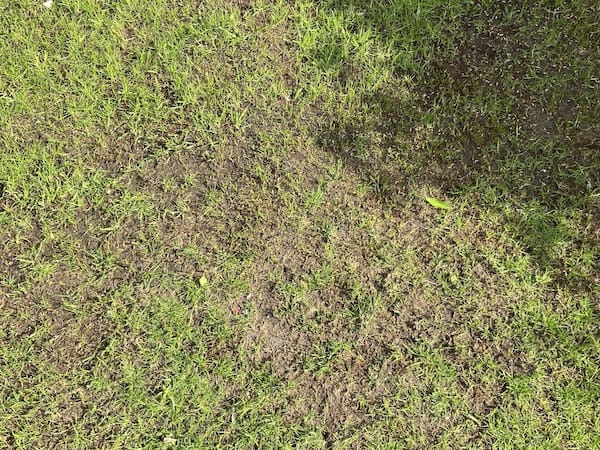
Check out my guide where I show you how I laid new turf in my own garden.
How to repair the dead patches on your lawn
The best time to repair your lawn is in spring or autumn because grass recovers well in these two seasons.
Follow me (below) as I repair my lawn and get it looking lush and green.
How do I re-seed the dead patches?
This procedure is easy, inexpensive and doesn’t take long to do at all. In fact, I had plenty of brown patches to repair across my lawn and it took me around 20 minutes from start to finish. However, it takes several weeks, if not longer, for the repaired patches to fully match the rest of the lawn and it usually takes 7 to 10 days alone just for the seed to germinate.
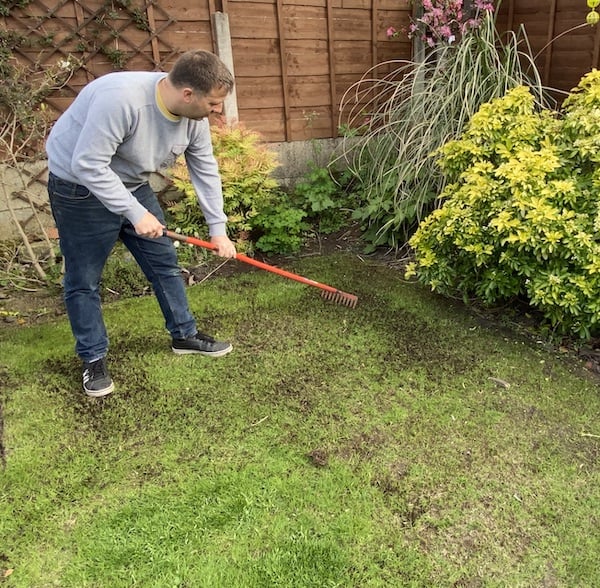
Using a rake, clear out any dead grass or debris from the affected area. You want to have a clean surface for germinating the new grass seed. You also want to lightly rake the surface of the soil to give the grass seed something to easily root into.
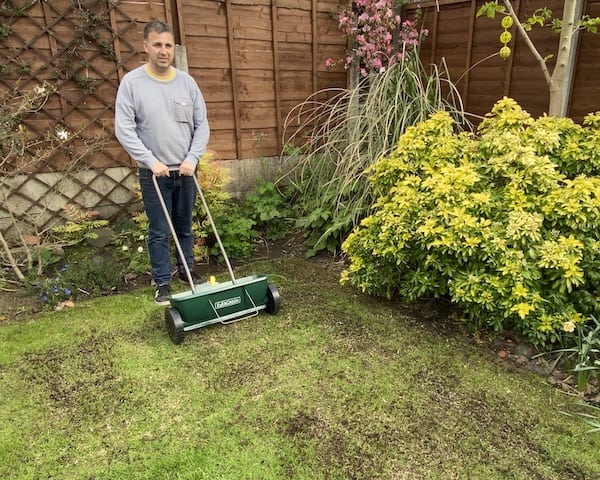
Next, it was time to spread the grass seed evenly. Me, I had a lot of dead patches to apply grass seed to so I decided to use my lawn spreader because this ensured an even application. While I was fixing the brown patches I thought I might as well overseed the whole lawn too.
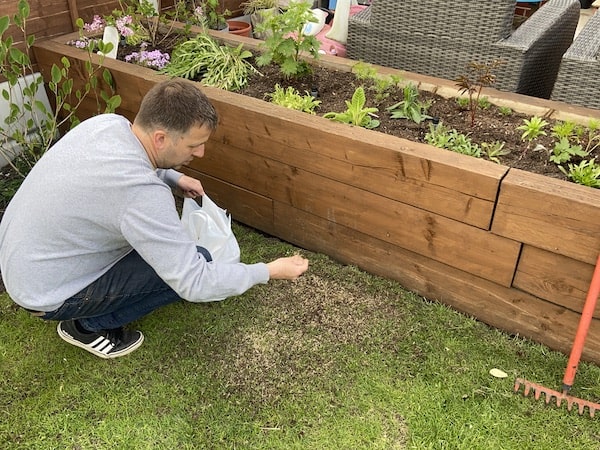
If you just have a couple of bare patches to repair, then you can sow the seed by hand as I did on this part of my lawn. Make sure you don’t apply too much grass seed because it can start to rot and cause more issues. You need a nice scattered layer. I also like to lightly rake the grass seed over to make sure it is well spread and not in clumps.
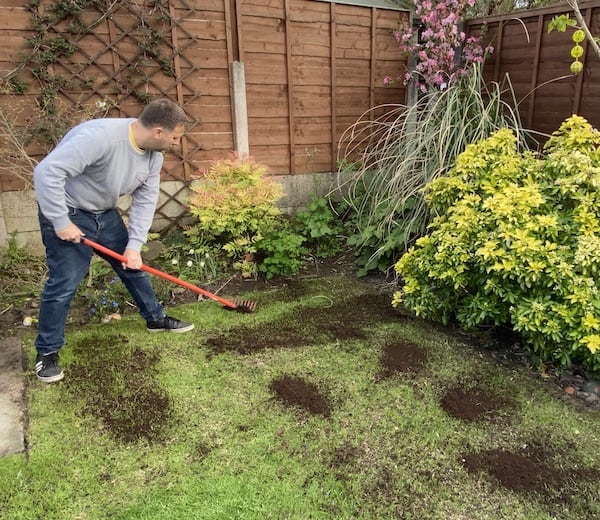
Once I have spread the grass seed over the bare patches, I then spread a premium compost over the seed and lightly rake it over.
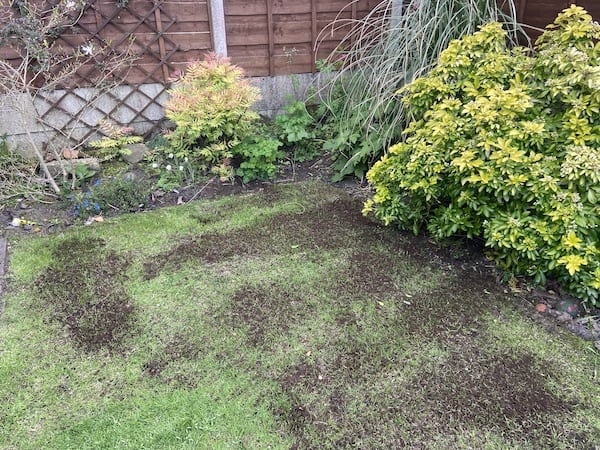
I find this does three things, firstly it keeps the grass seed moist and helps it germinate better, it also helps feed the lawn and finally makes it harder for the birds to feast on.
Finally, water the patches frequently at least once a day, twice a day if the weather is very warm until the grass is established. I actually used this water timer and this sprinkler to automate the watering so I don’t forget to turn it on and turn it off, I have done that more than once and left the sprinkler on overnight.
Once the grass is more than 4 inches in height, start mowing the area with the rest of the lawn. It will take about 2 to 3 mowing cycles until the grass blends in perfectly with the rest of the lawn.
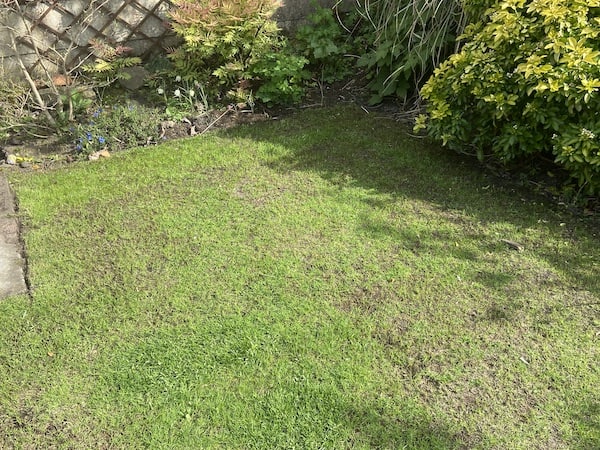
The picture above is my lawn before using grass seed to reseed the bare patches and the picture below is several weeks after the seed germinated after its first cut.
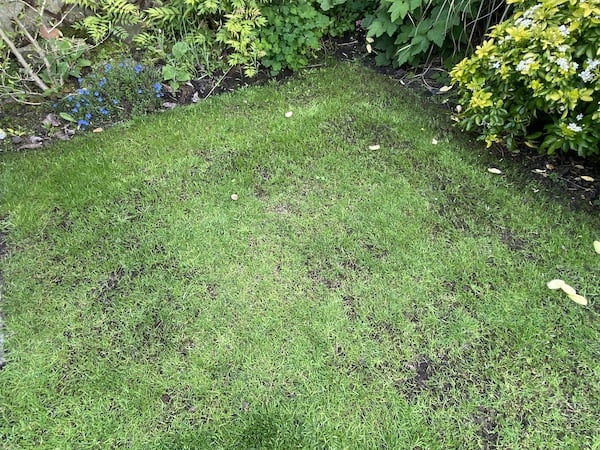
What causes dead patches in lawns?
Urine from pets
Pets and wild animals urinating in your garden will usually leave a brown patch because of the high concentration of urine that consumes the grass. The high nitrogen level in urine will usually leave a ring of dark green grass around the dead spot. This is a very common problem for homeowners who have pet dogs and the only precaution is to keep dogs off the lawn, however, this is usually not always possible because many people let their dogs onto the lawn for exercise.
Fungal diseases
Fungal diseases like ‘snow mould’ also known as Fusarium can harm patches of the lawn. They create a white web-like covering on the lawn that eventually kills grass in the infested area. Lawn diseases are hard to avoid and for the most part because of temporary environmental conditions. These can sometimes be prevented by improving the overall condition of the lawn by scarifying and spiking the lawn.
Spilt chemicals or petrol
Spilt pesticides and herbicides will usually cause dead spots in the lawn. Yet, even the most appropriate weedkillers, when applied in high concentration, can kill the grass. If you accidentally spill chemicals on your lawn, water the area thoroughly to mitigate the risk. Avoid refilling petrol lawnmowers and other petrol tools on the lawn to ensure no petrol gets spilt on the lawn.
Fertiliser burn
Excessively applying fertiliser to your lawn can burn the grass and leave dead patches. To avoid accidental spills or uneven application of fertiliser, be sure to load your lawn spreader off the lawn and apply the fertiliser steadily with your spreader. This is a very common cause of brown patches because gardeners apply a feed and moss killer at the wrong rate of application.
Improper sprinkler coverage
Uneven sprinkling may cause some small parts of the lawn to brown out and become latent. Whenever you are watering your lawn, try to observe the sprinkler action for a while to ensure uniform coverage. View our review of the best lawn sprinklers here.
These two methods have been tried and tested by gardeners and landscapers alike and they should, without a doubt, work for your lawn.
Follow these simple steps and your lawn will be looking nice and healthy in no time.



5 Comments
Good, clear information – thanks. Have another problem:
There are some very deep indentations on the lawn – this lawn was laid on a new building site, and think this is just the ground settling down. What is the quickest and most effective way of filling in these (quite large) indentations, please?
Hi Patricia, the only real way to fix this problem would be to buy some bags of topsoil and fill in the dips firming the soil down, then either replace with new turf or just reseed the patches. Ideally, you want to remove the turf from the dips first and maybe you can even put the turf back where it came from once you’ve filled the dips in. Hope this helps
Thank you so much for that information. Would I be correct in thinking this is best done in the autumn?
Yes this correct, while the ground is still warm before the cold weather comes.
Perfect for this winter! Thanks for sharing